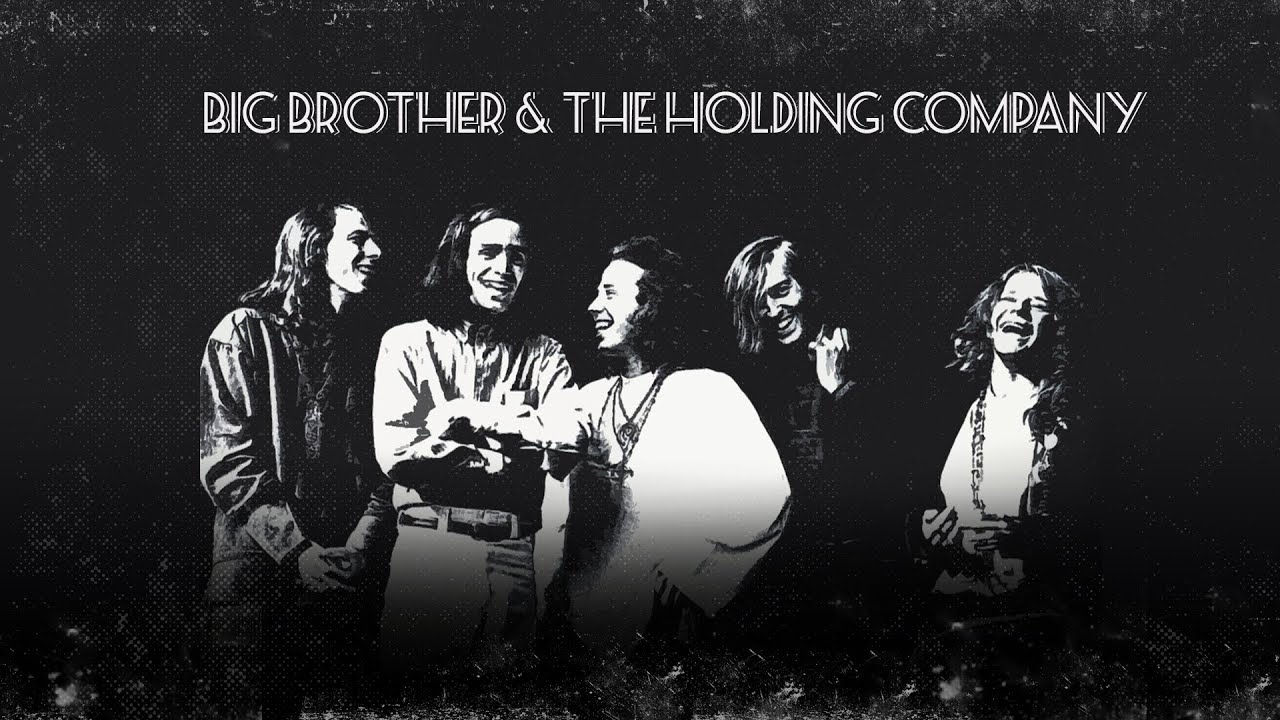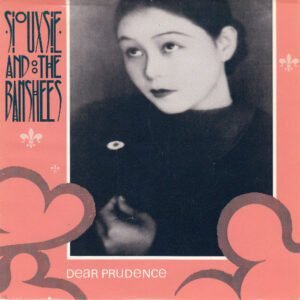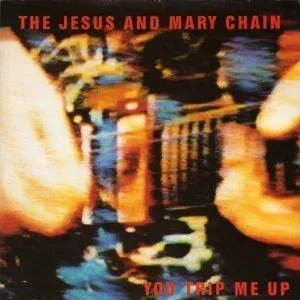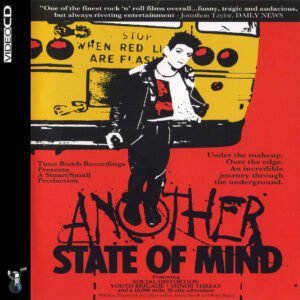Big Brother and the Holding Company – Full Concert – 08/16/68 – San Francisco
Description
Big Brother and the Holding Company – Full Concert Recorded Live: 8/16/1968 – San Francisco
0:00:00 – Down On Me
0:02:34 – Cuckoo
0:07:36 – Interview Part 1
0:08:29 – In the Hall of the Mountain King
0:15:20 – Interview Part 2
0:16:25 – Blow My Mind
0:20:24 – Interview Part 3
0:21:13 – Ball And Chain
0:28:07 – Interview Part 4
0:29:20 – Light Is Faster Than Sound
0:34:20 – Interview Part 5
From Wikipedia, the free encyclopedia
|
Big Brother and the Holding Company
|
|
|---|---|

Left to right: Getz, Joplin, Andrew, Gurley, Albin. c. 1967
|
|
| Background information | |
| Origin | San Francisco, California |
| Genres | |
| Years active | 1965–1968, 1969–1972, 1987–present |
| Labels | |
| Members |
|
| Past members |
|
| Website | bbhc |
Big Brother and the Holding Company are an American rock band that was formed in San Francisco in 1965 as part of the same psychedelic music scene that produced the Grateful Dead, Quicksilver Messenger Service, and Jefferson Airplane. After some initial personnel changes, the band became well known with the lineup of vocalist Janis Joplin, guitarists Sam Andrew and James Gurley, bassist Peter Albin, and drummer Dave Getz. Their second album Cheap Thrills, released in 1968, is considered one of the masterpieces of the psychedelic sound of San Francisco; it reached number one on the Billboard charts, and was ranked number 338 in Rolling Stone‘s the 500 greatest albums of all time. The album is also listed in the book 1001 Albums You Must Hear Before You Die.
Joplin left the band in 1968, following the recording of Cheap Thrills, for a successful solo career. The band recruited as new members Nick Gravenites, Kathi McDonald, and Dave Schallock to replace her, and released two more albums before breaking up in 1972. The classic lineup (minus Joplin, who had died in 1970) reunited in 1987. The band has continued to perform ever since, with a variety of different lead singers. James Gurley left for a solo career in 1997 and died in 2009. Sam Andrew died in 2015.
History
Roots in San Francisco
Leader Peter Albin, a country and blues guitarist who had played with future Grateful Dead‘s founders Jerry Garcia and Ron McKernan, met Sam Andrew, a professional rock guitarist with a jazz and classical background. After playing together at Albin’s home,[4] Andrew suggested they could form a band.[5] The pair approached guitarist James Gurley, and the resulting trio played open jam sessions hosted by entrepreneur Chet Helms in 1965. Helms found them a drummer, Chuck Jones, and “Big Brother and the Holding Company” was formed at their first gig, the Trips Festival in January 1966. In the audience there was painter and jazz drummer David Getz, who soon replaced Jones.
Big Brother went on to become the house band at the Avalon Ballroom,[6] playing a progressive style of instrumental rock. Feeling a need for a strong vocalist, Helms contacted Janis Joplin, who at the time was considering joining up with Roky Erickson of The 13th Floor Elevators. She traveled to San Francisco from Austin, Texas and debuted with Big Brother at the Avalon on June 10, 1966.[7][8][9]
Janis Joplin
Joplin sang for the first time with Big Brother in 1966. Years later, Andrew described the band’s first impressions of her:
We were the established rock and roll band. We were heavy. We were like: all right, out of three or four bands in this city, we are one of them. We’re in the newspapers all the time. We’re working out. We are doing this woman a favor to even let her come and sing with us. She came in and she was dressed like a little Texan. She didn’t look like a hippie, she looked like my mother, who is also from Texas. She sang real well but it wasn’t like, “Oh we’re bowled over.” It was probably more like, our sound was really loud. It was probably bowling her over. I am sure we didn’t turn down enough for her. She wrote letters home about how exotic all of us were. The names of the bands. That kind of thing. In other words, we weren’t flattened by her and she wasn’t flattened by us. It was probably a pretty equal meeting. She was real intelligent, Janis was, and she always rose to the occasion. She sang the songs. It wasn’t like this moment of revelation like you would like it to be. Like in a movie or something. It wasn’t like, “Oh my God, now we have gone to heaven. We have got Janis Joplin.” I mean she was good but she had to learn how to do that. It took her about a year to really learn how to sing with an electric band.[10]
It took a while for some of the band’s followers to accept the new singer, whose musical style differed from the experimental and unconventional sound that Big Brother played at the time. With the addition of Joplin, they became more disciplined musicians, their songs adopted a more traditional structure, and the band started to increase its popularity in the San Francisco psychedelic scene.
Mainstream Records debut
In September 1966, the band was stranded in Chicago after finishing a gig there at a venue called Mother Blues located on Wells Street. The venue’s owner paid them for two weeks’ worth of their concerts but could not pay them enough money for them to buy plane tickets to San Francisco. Big Brother signed a contract with Mainstream Records and recorded four songs for the album released as Big Brother & the Holding Company. The remainder of the record was recorded in Los Angeles on December 12–14. Mainstream was known for its jazz records, and Big Brother was the first rock band to appear on the label. This may have influenced the final result, since the album sounded very different from what the band expected: acoustic and folk instead of heavy acid rock.[citation needed]
The first single released was “Blind Man” b/w “All Is Loneliness”, both from sessions in Los Angeles, in October 1966. It was popular in the San Francisco Bay Area, but did not garner any national attention. A second single, “Down on Me” b/w “Call On Me” was released in March 1967, with “Bye Bye Baby” following along with the album in August after the band’s national success at the Monterey Pop Festival. The album debuted on Billboard charts on September 2, 1967, peaking at No. 60. It stayed on the charts for a total of 30 weeks.
The Pop Chronicles criticized the record as difficult to find and “technically disappointing”.[12] “Down On Me” had a long gestation in the marketplace and finally debuted on the Billboard Hot 100 chart on August 31, 1968, peaking at No. 43. It stayed on the charts for 8 weeks. Other singles from the album were released through the end of 1967 and in 1968. “Coo Coo” b/w “The Last Time”, was released in January, 1968.[13] These last songs were from the original 1966 album sessions, but were not included on the LP until Columbia acquired all of the band’s Mainstream recordings and reissued the album in the 1970s.[14][15]
In the summer of 1966, the band members moved to Lagunitas, in Marin County, California, to a house that had been originally built by the ethnologist Clinton Hart Merriam. They lived in there until the beginning of 1967 at which time they put an ad in the San Francisco Oracle with the apparent intention of moving back to the “City”. The ad read: “Big Brother is returning to the city. Need rehearsal hall and a place to live. Write to B.B.& the H.C. at Box 94 Lagunitas.”[16]
Mantra-Rock Dance
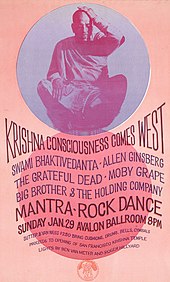
One of the band’s earliest major performances in 1967 was the Mantra-Rock Dance—a musical event held on January 29, 1967, at the Avalon Ballroom by the San Francisco Hare Krishna temple. Big Brother and Janis Joplin performed there along with Hare Krishna founder Bhaktivedanta Swami, Allen Ginsberg, Moby Grape, and Grateful Dead, donating proceeds to the Krishna temple.[17][18][19]
Monterey Pop Festival
The band’s historic performance at the Monterey Pop Festival in June 1967 attracted national and international attention.[20] The band was scheduled to play on Saturday afternoon, with a set which included “Down on Me”, “Combination of The Two”, “Harry”, “Roadblock” and “Ball and Chain“. However, the band’s manager decided not to allow Pennebaker’s film crew to film and record them without paying them, and ordered the crew to turn its cameras off. The festival promoters thought the band performance was great, and asked them to play again the next evening in order to record it on film, but they played only two songs: “Combination of The Two” and “Ball and Chain”. “I remember being amazed that this white woman was singing like Bessie Smith,” said Michelle Phillips once. “I was astounded”. They signed a contract with Columbia Records, which was able to buy out their contract from Mainstream.[20] In late November, Albert Grossman, who was then managing Bob Dylan, Peter, Paul and Mary and several other acts became their manager.[21]
National success
Having received national recognition after the Monterey Pop Festival, Big Brother was booked by Grossman for engagements around the country. One of those engagements was for opening night at Chet Helm’s The Family Dog Denver on September 8 & 9, 1967 along with Blue Cheer. A well-known band on the West Coast (especially in San Francisco), Big Brother played their first East Coast concert in New York City on February 17, 1968, at the Anderson Theater, 66 Second Avenue. Columbia’s marketing department featured Janis Joplin as the star; before that time, some of the band’s audience regarded James Gurley as of equal or more importance. In New York the press criticized the band for playing out of tune and for amplifiers set at maximum volume. The Village Voice, while noting that “ears came out ringing” after the Saturday night performance, cited Joplin as ranking in sex appeal with Jim Morrison and Jimi Hendrix, and praised “her belting, groovy style,” mixing Bessie Smith, Aretha Franklin and James Brown. “At times she seemed to be singing harmony with herself.” Big Brother was the first band to play in the legendary Fillmore East, in New York City, on March 8, 1968. The other acts that night were Albert King and Tim Buckley.[22]
Cheap Thrills
The band’s first album for Columbia was due to be recorded during the spring and summer of 1968, and released in August of that year. It was eagerly anticipated after the first LP had been largely ignored. Initially planned as a live album, the band recorded two concerts at Grande Ballroom in Detroit, but the results did not satisfy the producer John Simon nor the manager Albert Grossman.
The live album was scrapped and Columbia decided to re-record most of the songs in the studio (“Down on Me” and “Piece of My Heart“, taken from the Grande Ballroom concerts, were later released as part of Joplin’s live album In Concert in 1972). However, it was difficult adapting their raw sound and unorthodox work habits with the realities of a professional studio. The progress was slow, and the pressure from Grossman, Columbia, and the press increased.[20] A few of the band members believed that John Simon should not be the producer, believing that he came from a different musical style and did not understand the band’s psychedelic, guitar based sound.[23]
The album was initially named Sex, Dope and Cheap Thrills, but Columbia asked them to shorten it to just Cheap Thrills. For the album cover the band was photographed by Richard Avedon but the pictures were not used. Also rejected was a photo of the band naked in a hotel room bed. Dave Getz suggested that the band hire underground comic-book artist R. Crumb whom he knew through a mutual friend. What was originally meant to be the back cover art became the classic cover of the album. For the back cover, Columbia chose a black and white photo of Joplin.
“Ball and Chain” is the only song on the album recorded entirely live, and even though the cover credits assert that the live material was recorded at Bill Graham‘s Fillmore Auditorium, it was actually taken from a concert in Winterland Ballroom in 1968, the same version that appears on the album Live at Winterland ’68, released in 1998.[24] (The performance of “Ball and Chain” as released on the Winterland album features a different opening guitar solo by Gurley, indicating that he had dubbed a different intro for the Cheap Thrills issue.[citation needed])
The LP was released in August 1968, one year after their debut album, and reached number one on the Billboard charts in its eighth week in October. It held the number one spot for eight (nonconsecutive) weeks, and the single “Piece of My Heart” also became a huge hit. By the end of the year it was one of the most successful albums of 1968. It was certified gold by the R.I.A.A. on October 15 that year for $1 million worth of sales, with subsequent sales pushing the total over a million units.[25] Even though the album was released with only seven songs, the other eight songs which were not included were released on subsequent albums. “Catch Me Daddy” and “Farewell Song” were among their most popular songs. These plus “Magic of Love”, a medley of “Amazing Grace” and “Hi-Heel Sneakers”, and an outtake of “Harry” first appeared on Farewell Song, a posthumous Joplin release in 1981; they also appeared on the three-CD set Janis in 1993. “It’s a Deal” and “Easy Once you Know How” were released in Box of Pearls in 1999. “Flower in The Sun” and “Roadblock” were released on the Cheap Thrills reissue CD as bonus tracks.[26][27][28] “Piece of My Heart” would be reissued on a single in the Columbia Hall of Fame oldies series – backed by the title cut from Joplin’s first 1969 solo album, I Got Dem Ol’ Kozmic Blues Again Mama!.
Split with Joplin
At the end of the summer of 1968, just after the release of Cheap Thrills, Joplin announced that she was leaving Big Brother in the fall of that year. The official reason given was her desire to go solo and form a soul music band. Andrew also planned to leave the band to join Joplin in her new project.[20] Joplin played with Big Brother on a nationwide tour throughout October and November 1968.[29] It included an October 20 concert at a roller rink in Alexandria, Virginia.[30] Their final concert was in San Francisco on December 1, 1968. It was a benefit for the production company known as the Family Dog whose members included Chet Helms, the band’s manager from two years earlier. Three weeks after this benefit concert, Joplin and Andrew played in Memphis for the first time with her new band, later called Kozmic Blues Band.[31]
(San Francisco, CA) More Big Brother and the Holding Company at Music Vault: http://www.musicvault.com




